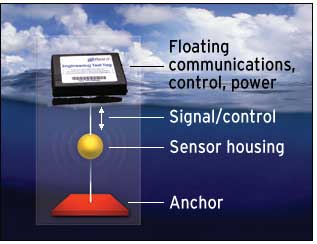Oct 01, 2008U.S. soldiers operating in remote areas need to find safe drinking water. Often they must do repeated tests on the same water source to check for the presence of hazardous organisms. Now, the military is seeking a device that would continuously monitor water supplies for three common waterborne pathogens, Vibrio cholerae, E. coli and Giardia intestinalis, and use RFID technology to send an alert when dangerously high levels are detected.
In January, the Defense Advanced Research Projects Agency (DARPA) awarded a one-year contract to develop the device to two Boulder, Colo., companies. Sporian Microsystems, a startup that develops microsensors, and Phase IV Engineering, a radio frequency systems developer, are collaborating to develop a prototype by the end of this year, though their contract could be extended through late 2006.
The device, which will float, consists of a sensor connected to an active RFID transponder. The sensor will be submerged, and the RF antenna will sit above the water. When a sensor detects a preset level of a pathogen, say, 1 part per million, it will trigger an optical signal that will be detected by a microchip in the RFID transponder, which, in turn, will communicate the danger.
Sporian is developing the sensor, and Phase IV Engineering is currently working on two possible ways the device could communicate the presence of a pathogen. One is a self-configuring network of RFID transponders that would pass data from one node to another until the information reaches a final node that transmits an alarm about water contamination to a central monitoring station via a satellite communication system. Another option is to use handheld readers to query the devices.
Kevin Harsh, Sporian’s project lead, says that the fundamental research could be applied to sensors that would detect other pathogens and toxins, including those that could be used as airborne and waterborne biological or chemical weapons.
The technology exists today to create effective sensor networks, but commercializaton could take several years. “In the long term, we could have low-cost sensors in every town’s water supply,” says Rich Pollack, president of Phase IV. “And they could be set up to detect not just cholera, but almost any waterborne pathogen.”

